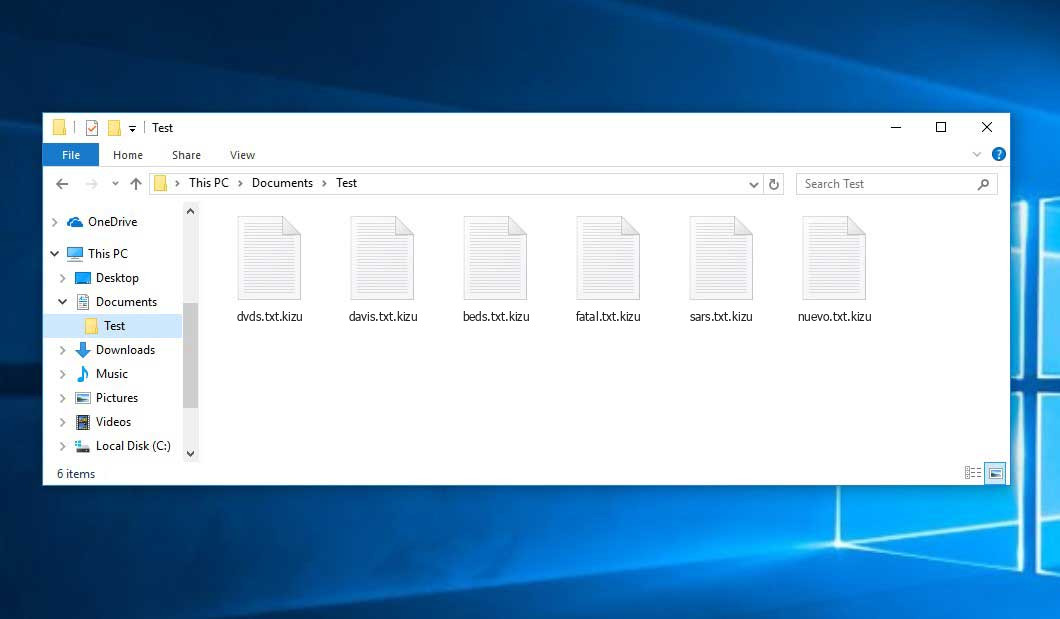The Kizu virus, also known as a ransomware infection, is part of the STOP/DJVU family, which is notorious for its malicious file encryption capabilities. When the Kizu virus infects a computer system, it targets various types of files, such as videos, photos, documents, and more. It modifies the file structure and appends the “.kizu” extension to each encrypted file, making them inaccessible and unusable without the decryption key.
What Is Kizu Virus?
KIZU
🤔 Kizu virus is ransomware that originates from the DJVU/STOP family. Its primary purpose is to encrypt files that are important to you. After that ransomware virus asks its victims for a ransom fee ($490 – $980) in Bitcoin.
The Kizu virus is a type of malware that encrypts your files and coerces you into paying for their restoration. This ransomware encrypts various file types which become identifiable by a distinct “.kizu” extension. As a result, the affected files become inaccessible and unusable. Subsequently, the ransomware demands a ransom payment in Bitcoin from its victims, ranging from $490 to $980. Typically, a ransom text file named “_readme.txt“.
Kizu Ransomware operates by Salsa20 encryption algorithms to scramble the contents of the targeted files. In the case of the Kizu virus, it utilizes a robust encryption method that makes it incredibly difficult, if not impossible, to calculate the decryption key without the assistance of the attackers.
Once the files are encrypted, the Kizu virus displays a ransom note to the victim, demanding a ransom payment in exchange for the decryption key. The ransom note provides instructions on how to make the payment and often includes threats of permanent data loss or increased ransom amounts if the demands are not met within a specified timeframe.
I have compiled a comprehensive list of potential solutions, tips, and practices to neutralize the Kizu virus and decrypt file encryption. In some cases, it may be feasible to restore your files, while in others, it may be impossible.
Kizu employs a unique key for each victim, with one exception:
- If Kizu fails to establish a connection with its command and control server (C&C Server) before starting the encryption process, it resorts to using offline keys. This means that the same key is used for all users, allowing for the decryption of files encrypted by the ransomware.
The Kizu virus bears resemblance to other DJVU ransomware variants such as Kitu, Mitu, Miza, and Miqe Virus. This virus encrypts a wide range of common file types and appends its distinct “.kizu” extension to all files. For instance, a file named “1.jpg” would be altered to “1.jpg.kizu” and “2.png” to “2.png.kizu“. Upon successful encryption, the virus creates a special text file named “_readme.txt” and places it in every folder containing the encrypted files.
The image below provides a visual representation of files with the “.kizu” extension:
| Name | Kizu Virus |
| Ransomware family1 | DJVU/STOP2 ransomware |
| Extension | .kizu |
| Ransomware note | _readme.txt |
| Ransom | From $490 to $980 (in Bitcoins) |
| Contact | [email protected], [email protected] |
| Detection | Trojan:MSIL/XWormRAT.A!MTB, Ransom.Bluesky.S29960716, WinGo/RanumBot.B |
| Symptoms |
|
| Fix Tool | To remove possible malware infections, scan your PC: 6-day free trial available. |
This is a _readme.txt file requesting payment to retrieve files through a decryption key:
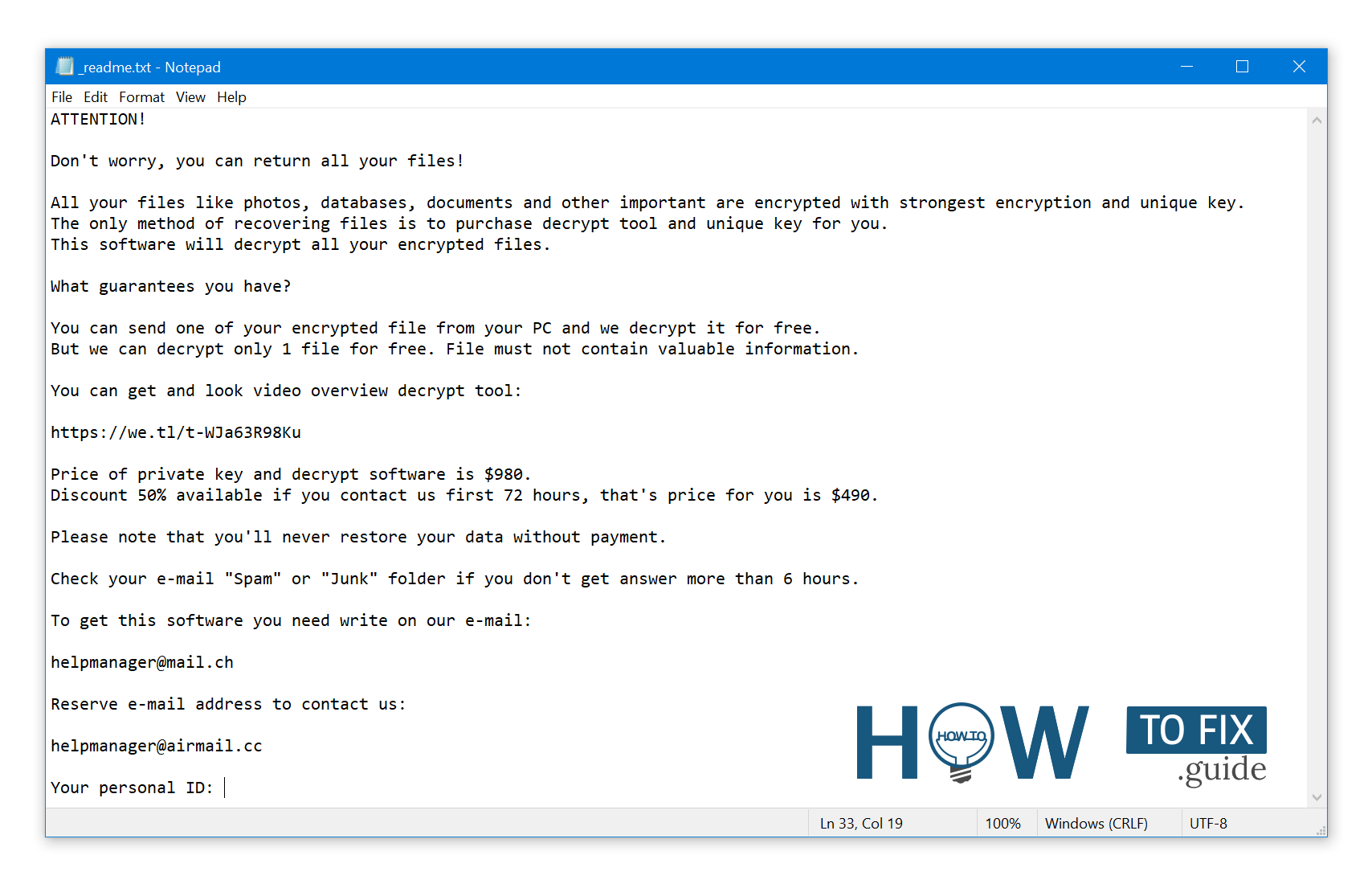
_readme.txt (STOP/DJVU Ransomware) – The scary alert demanding from users to pay the ransom to decrypt the encoded files contains these frustrating warnings
The Kizu ransomware executes various processes on the victim’s computer to carry out its tasks. Among these processes is winupdate.exe, a deceptive program that presents a fake Windows update prompt during the attack. The intention is to mislead the victim into believing that a sudden system slowdown is due to a Windows update. However, simultaneously, the ransomware initiates another process (often named with four random characters) to scan the system for targeted files and encrypt them. Additionally, the ransomware eliminates Volume Shadow Copies from the system using the following CMD command:
vssadmin.exe Delete Shadows /All /Quiet
Once deleted, restoring the previous computer state using System Restore Points becomes impossible. The ransomware operators eliminate any Windows OS-based methods that could aid the victim in recovering files without paying the ransom. Furthermore, the cybercriminals tamper with the Windows HOSTS file by adding a list of domains and mapping them to the localhost IP. As a result, when attempting to access any of the blocked websites, the victim will encounter a DNS_PROBE_FINISHED_NXDOMAIN error.
We have observed that the ransomware also attempts to block websites that publish various how-to guides for computer users. It is evident that, by restricting specific domains, the criminals aim to hinder the victim from accessing relevant and helpful information about ransomware attacks online. Moreover, the virus deposits two text files on the victim’s computer containing attack-related information – the victim’s public encryption key and personal ID. These two files are named bowsakkdestx.txt and PersonalID.txt.
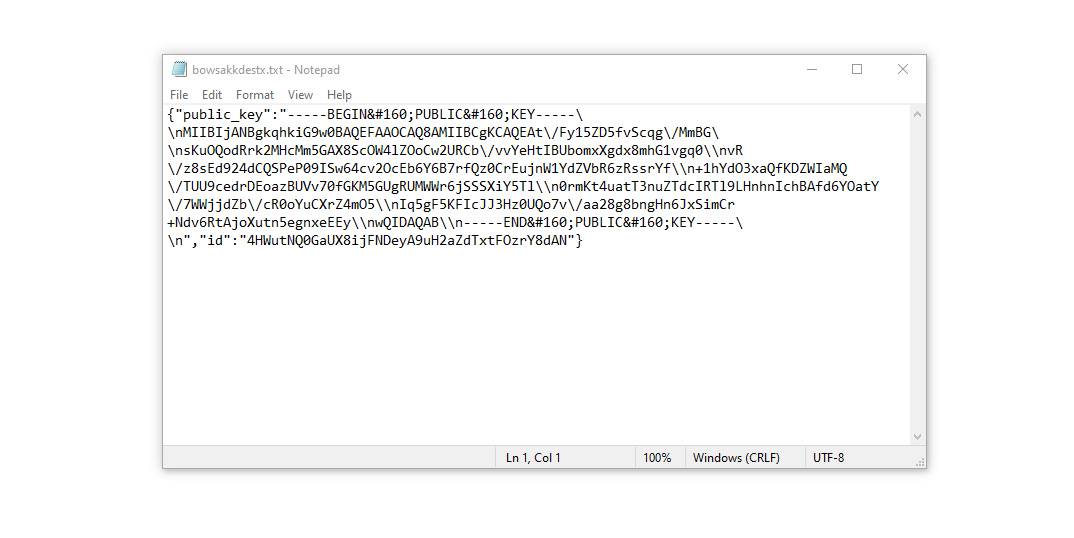
Even after these modifications, the malware doesn’t cease its activity. Variants of STOP/DJVU often inject the Vidar password-stealing Trojan into compromised systems. This threat boasts an extensive range of capabilities:
- Stealing Steam, Telegram, Skype login/password;
- Stealing cryptocurrency wallets;
- Downloading and executing malware on the computer;
- Extracting browser cookies, saved passwords, browsing history, and more;
- Viewing and manipulating files on the victim’s computer;
- Enabling hackers to execute various tasks on the victim’s computer remotely.
The DJVU/STOP ransomware family employs the AES-256 cryptography algorithm. Consequently, if your files have been encrypted with an online decryption key (which is entirely unique), decrypting the files without the specific key is impossible.
If Kizu operated in online mode, gaining access to the AES-256 key is unfeasible. The key is stored on a remote server owned by the criminals promoting the Kizu ransomware.
To receive the decryption key, a payment of $980 is required. For obtaining payment details, victims are encouraged to contact the frauds via email ([email protected]).
The message by the ransomware states the following information:
ATTENTION! Don't worry, you can return all your files! All your files like photos, databases, documents and other important are encrypted with strongest encryption and unique key. The only method of recovering files is to purchase decrypt tool and unique key for you. This software will decrypt all your encrypted files. What guarantees you have? You can send one of your encrypted file from your PC and we decrypt it for free. But we can decrypt only 1 file for free. File must not contain valuable information. You can get and look video overview decrypt tool: https://we.tl/t-WJa63R98Ku Price of private key and decrypt software is $980. Discount 50% available if you contact us first 72 hours, that's price for you is $490. Please note that you'll never restore your data without payment. Check your e-mail "Spam" or "Junk" folder if you don't get answer more than 6 hours. To get this software you need write on our e-mail: [email protected] Reserve e-mail address to contact us: [email protected] Your personal ID: XXXXXXXXXXXXXXXXXXXXXXXXXXXXXXX
Do not pay for KIZU!
Please, try to use the available backups, or Decrypter tool
When your files are encrypted by ransomware, it’s crucial to act promptly and wisely. The readme.txt file clearly states that you must contact Kizu representatives within 72 hours to receive a 50% rebate, reducing the ransom amount to $490. However, paying the ransom should be avoided at all costs!
I highly recommend refraining from any contact with these fraudsters and resisting the temptation to pay. The most effective solution for recovering lost data is utilizing available backups or the Decrypter tool from Emsisoft.
Ransomware operates in a consistent manner, generating unique decryption keys for data recovery. Unless the ransomware has significant flaws, manual recovery of encrypted data is nearly impossible. Regularly backing up your crucial files is the only way to protect your valuable data.
Even if you maintain backups regularly, it’s essential to store them in a specific location separate from your main workstation. Consider using a USB flash drive, an external hard drive, or opt for online (cloud) information storage services.
Remember, keeping your backup data on your common device might also render it susceptible to encryption by ransomware. Thus, storing the backup on your main computer is not a wise decision.
By following these smart backup practices and being vigilant against ransomware, you can safeguard your data and avoid falling victim to malicious attacks.
Stay informed, stay protected!
How I was infected?
Ransomware has a various methods to built into your system. But it doesn’t really matter what method had place in your case.

Kizu attack following a successful phishing attempt.
However, the Kizu ransomware can find its way into your PC through common leaks:
- It may hide within other apps, particularly utilities offered as freeware or shareware.
- You might unknowingly install it through suspicious links in spam emails.
- It can exploit online free hosting resources as well.
- Downloading pirated software from illegal peer-to-peer (P2P) resources can also inject the ransomware.
In some cases, the Kizu virus disguises itself as a legitimate tool, often appearing as messages demanding unwanted software or browser updates. Online fraudsters may trick you into manually installing the ransomware by making you participate in the process.
They often use bogus update alerts, concealing the virus installation under false claims of updating Adobe Flash Player or some other dubious program.
Cracked apps can also lead to trouble, as using P2P for illegal downloads may introduce serious malware, including the Kizu ransomware.
So, what can you do to avoid falling victim to the Kizu ransomware? While no method offers absolute certainty, I have some helpful tips to prevent its infiltration. Always exercise caution when installing free software.
Take the time to read through what the installers offer besides the main program. Avoid opening dubious email attachments and refrain from accessing files from unknown senders. Ensure that your security program is consistently updated.
The malware operates discreetly, evading detection in your list of available programs. Instead, it operates silently in the background, initiating from the moment you start your PC.
How To Remove Kizu Virus?
In addition to encode a victim’s files, the Djvu virus has also started to install the Vidar Stealer on system to steal account credentials, cryptocurrency wallets, desktop files, and more.
Remove Kizu Virus with Gridinsoft Anti-Malware
We have also been using this software on our systems ever since, and it has always been successful in detecting viruses. It has blocked the most common Ransomware as shown from our tests with the software, and we assure you that it can remove Kizu Virus as well as other malware hiding on your computer.

To use Gridinsoft for remove malicious threats, follow the steps below:
1. Begin by downloading Gridinsoft Anti-Malware, accessible via the blue button below or directly from the official website gridinsoft.com.
2.Once the Gridinsoft setup file (setup-gridinsoft-fix.exe) is downloaded, execute it by clicking on the file.

3.Follow the installation setup wizard's instructions diligently.

4. Access the "Scan Tab" on the application's start screen and launch a comprehensive "Full Scan" to examine your entire computer. This inclusive scan encompasses the memory, startup items, the registry, services, drivers, and all files, ensuring that it detects malware hidden in all possible locations.

Be patient, as the scan duration depends on the number of files and your computer's hardware capabilities. Use this time to relax or attend to other tasks.
5. Upon completion, Anti-Malware will present a detailed report containing all the detected malicious items and threats on your PC.

6. Select all the identified items from the report and confidently click the "Clean Now" button. This action will safely remove the malicious files from your computer, transferring them to the secure quarantine zone of the anti-malware program to prevent any further harmful actions.

8. If prompted, restart your computer to finalize the full system scan procedure. This step is crucial to ensure thorough removal of any remaining threats. After the restart, Gridinsoft Anti-Malware will open and display a message confirming the completion of the scan.
Remember Gridinsoft offers a 6-day free trial. This means you can take advantage of the trial period at no cost to experience the full benefits of the software and prevent any future malware infections on your system. Embrace this opportunity to fortify your computer's security without any financial commitment.
Trojan Killer for “Kizu Virus” removal on locked PC
In situations where it becomes impossible to download antivirus applications directly onto the infected computer due to malware blocking access to websites, an alternative solution is to utilize the Trojan Killer application.

There is a really little number of security tools that are able to be set up on the USB drives, and antiviruses that can do so in most cases require to obtain quite an expensive license. For this instance, I can recommend you to use another solution of GridinSoft - Trojan Killer Portable. It has a 14-days cost-free trial mode that offers the entire features of the paid version. This term will definitely be 100% enough to wipe malware out.
Trojan Killer is a valuable tool in your cybersecurity arsenal, helping you to effectively remove malware from infected computers. Now, we will walk you through the process of using Trojan Killer from a USB flash drive to scan and remove malware on an infected PC. Remember, always obtain permission to scan and remove malware from a computer that you do not own.
Step 1: Download & Install Trojan Killer on a Clean Computer:
1. Go to the official GridinSoft website (gridinsoft.com) and download Trojan Killer to a computer that is not infected.

2. Insert a USB flash drive into this computer.
3. Install Trojan Killer to the "removable drive" following the on-screen instructions.

4. Once the installation is complete, launch Trojan Killer.
Step 2: Update Signature Databases:
5. After launching Trojan Killer, ensure that your computer is connected to the Internet.
6. Click "Update" icon to download the latest signature databases, which will ensure the tool can detect the most recent threats.

Step 3: Scan the Infected PC:
7. Safely eject the USB flash drive from the clean computer.
8. Boot the infected computer to the Safe Mode.
9. Insert the USB flash drive.
10. Run tk.exe
11. Once the program is open, click on "Full Scan" to begin the malware scanning process.

Step 4: Remove Found Threats:
12. After the scan is complete, Trojan Killer will display a list of detected threats.

13. Click on "Cure PC!" to remove the identified malware from the infected PC.
14. Follow any additional on-screen prompts to complete the removal process.

Step 5: Restart Your Computer:
15. Once the threats are removed, click on "Restart PC" to reboot your computer.
16. Remove the USB flash drive from the infected computer.
Congratulations on effectively removing Kizu Virus and the concealed threats from your computer! You can now have peace of mind, knowing that they won't resurface again. Thanks to Gridinsoft's capabilities and commitment to cybersecurity, your system is now protected.
How To Decrypt .kizu Files?
How to restore big .kizu files?
Try removing .kizu extension on a few BIG files and opening them. Either the Kizu ransomware read and did not encrypt the file, or it bugged and did not add the filemarker. If your files are very large (2GB+), the latter is most likely. Please, let me know in comments if that will work for you.
The newest extensions released around the end of August 2019 after the criminals made changes (this includes Kiqu Virus also).
As a result of the changes made by the criminals, STOPDecrypter is no longer supported. It has been removed and replaced with the Emsisoft Decryptor for STOP Djvu Ransomware developed by Emsisoft.
You can download free decryption tool here: Decryptor for STOP Djvu.
Download and run decryption tool.
Start downloading the decryption tool.
Make sure to launch the decryption utility as an administrator. You need to agree with the license terms that will come up. For this purpose, click on the “Yes” button:

As soon as you accept the license terms, the main decryptor user interface comes up:

Select folders for decryption.
Based on the default settings, the decryptor will automatically populate the available locations in order to decrypt the currently available drives (the connected ones), including the network drives. Extra (optional) locations can be selected with the help of the “Add” button.
Decryptors normally suggest several options considering the specific malware family. The current possible options are presented in the Options tab and can be activated or deactivated there. You may locate a detailed list of the currently active Options below.
Click on the “Decrypt” button.
As soon as you add all the desired locations for decryption into the list, click on the “Decrypt” button in order to initiate the decryption procedure.
Note that the main screen may turn you to a status view, letting you know of the active process and the decryption statistics of your data:

The decryptor will notify you as soon as the decryption procedure is completed. If you need the report for your personal papers, you can save it by choosing the “Save log” button. Note that it is also possible to copy it directly to your clipboard and to paste it into emails or messages here if you need to do so.
The Emsisoft Decryptor might display different messages after a failed attempt to restore your kizu files:
✓ Error: Unable to decrypt file with ID: [your ID]
✓ No key for New Variant online ID: [your ID]
Notice: this ID appears to be an online ID, decryption is impossible
✓ Result: No key for new variant offline ID: [example ID]
This ID appears be an offline ID. Decryption may be possible in the future.
It can take a few weeks or months until the decryption key gets found and uploaded to the decryptor. Please follow updates regarding the decryptable DJVU versions here.
✓ Remote name could not be resolved
How to Restore .kizu Files?
In some case Kizu ransomware is not doom for your files…
Kizu ransomware encryption mechanism feature is next: it encrypts every file byte-by-byte, then saves a file copy, deleting (and not overriding!) the original file. Hence, the information of the file location on the physical disk is lost, but the original file is not deleted from the physical disk. The cell, or the sector where this file was stored, can still contain this file, but it is not listed by the file system and can be overwritten by data that has been loaded to this disk after the deletion. Hence, it is possible to recover your files using special software.
However, I soon realized that the virus operates as an online algorithm, rendering it impossible to retrieve my encrypted files. At the time of the virus attack, my backup drive was plugged in, and unfortunately, it too got infected. Consequently, every single folder within the backup drive suffered from encryption. Despite this setback, I was fortunate enough to salvage almost 80% of my 2TB storage.
Upon closer inspection of the folders, I noticed the presence of the readme.txt ransom note in each one. Upon opening some folders, I discovered that all files situated outside subfolders within those folders had been encrypted. A glimmer of hope emerged when I delved into subfolders in other folders and found that these files remained untouched by the encryption. Surprisingly, all folders within my C and D drives, including subfolders, had been encrypted, but thankfully, this was not the case with the backup drive. The use of subfolders within the backup drive turned out to be a savior, ensuring the safety of 80% of my precious data.
While this discovery provided a sense of relief, I believe it to be only a minor loophole in the security of the backup drive. On a more positive note, I managed to retrieve an additional 10% of my data from another hard drive connected to a different PC. Consequently, I urge anyone using a backup drive to create subfolders as a precautionary measure. It appears that luck was on my side, although it was unfortunate that the virus struck while I was in the process of transferring files from my backup.
In conclusion, my encounter with the Kizu virus has taught me valuable lessons about data security and the significance of thoughtful backup practices. By sharing my experience, I hope to help others safeguard their digital assets and avoid the distress caused by such malicious attacks. Transitioning to a more secure digital environment through proactive measures is paramount in today’s interconnected world.
Hopefully, this can help some other people in my situation.
Jamie NewlandRecovering your files with PhotoRec
PhotoRec is an open-source program that was initially designed for recovering files from damaged disks or in case of accidental deletions. Over time, its capabilities expanded, and now it can successfully recover files of 400 different extensions, making it a valuable tool for data recovery after a ransomware attack.
First and foremost, you should download PhotoRec
application. It is absolutely free, although the developer does emphasize that there is no guarantee for file recovery. PhotoRec is distributed alongside another utility from the same developer called TestDisk. Don’t be concerned when you see the TestDisk name in the downloaded archive; the PhotoRec files are right inside.
To access PhotoRec, simply locate and open the file named “qphotorec_win.exe”. The best part is that no installation is required. All the necessary files are contained within the archive, allowing you to conveniently store it on your USB drive and lend a helping hand to your friends, parents, or anyone who has fallen victim to the DJVU/STOP ransomware.
Get started today and experience the power of PhotoRec in recovering your valuable files!
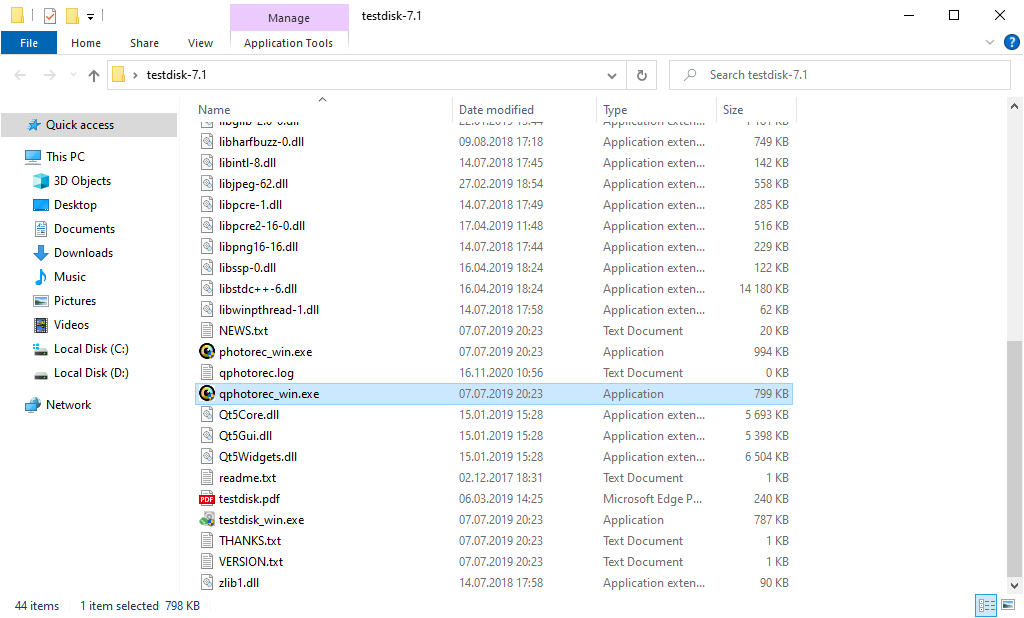
After the launch, you will see the screen showing you the full list of your disk spaces. However, this information is likely useless, because the required menu is placed a bit higher. Click this bar, then choose the disk which was attacked by ransomware.
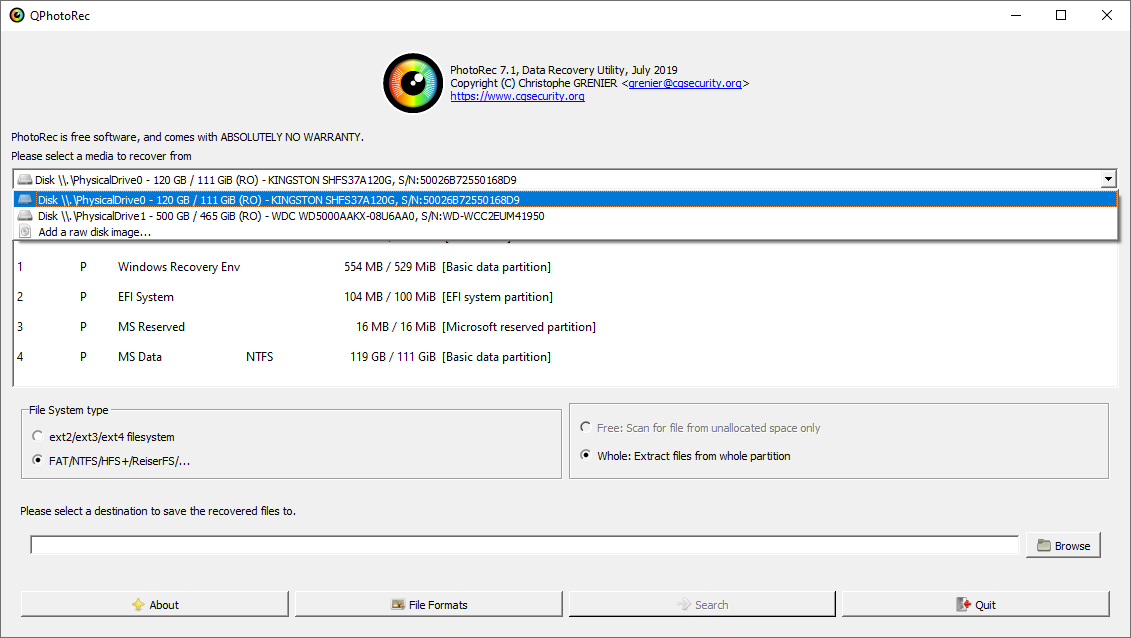
After choosing the disk, you need to choose the destination folder for the recovered files. This menu is located at the lower part of the PhotoRec window. The best desicion is to export them on USB drive or any other type of removable disk.
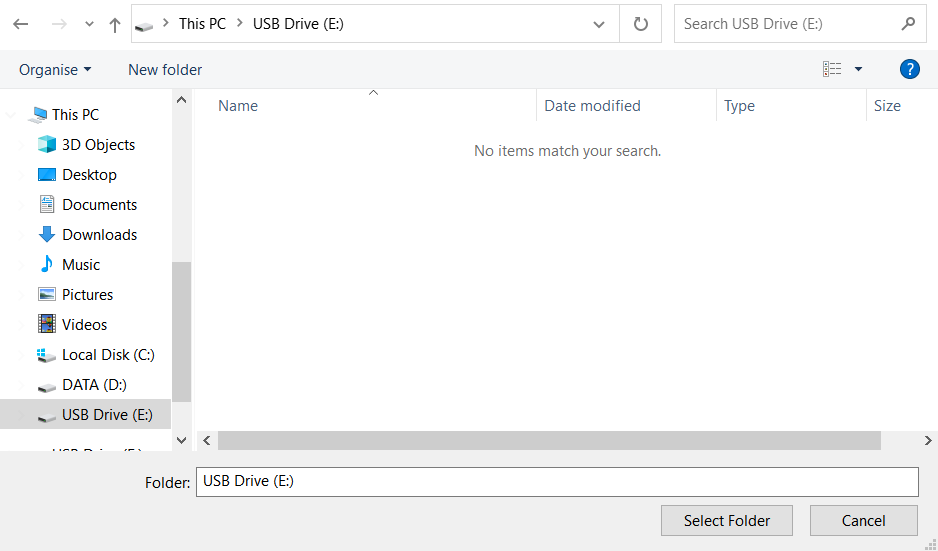
Then, you need to specify the file formats. This option is located at the bottom, too. As it was mentioned, PhotoRec can recover the files of about 400 different formats.
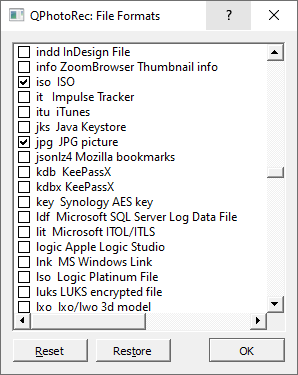
Finally, you can start files recovery by pressing the “Search” button. You will see the screen where the results of the scan and recovery are shown.
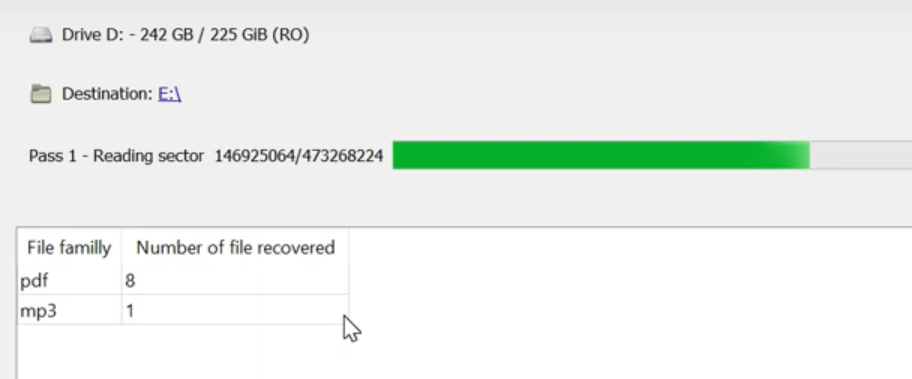
Kizu files recovery guide
Frequently Asked Questions
No way. These files are modified by ransomware. The contents of .kizu files are not available until they are decrypted.
If your data remained in the .kizu files are very valuable, then most likely you made a backup copy.
If not, then you can try to restore them through the system function – Restore Point.
All other methods will require patience.
Of course not. Your encrypted files do not pose a threat to the computer. What happened has already happened.
You need GridinSoft Anti-Malware to remove active system infections. The virus that encrypted your files is most likely still active and periodically runs a test for the ability to encrypt even more files. Also, these viruses install keyloggers and backdoors for further malicious actions (for example, theft of passwords, credit cards) often.
In this situation, you need to prepare the memory stick with a pre-installed Trojan Killer.
Have patience. You are infected with the new version of STOP/DJVU ransomware, and decryption keys have not yet been released. Follow the news on our website.
We will keep you posted on when new Kizu keys or new decryption programs appear.
The Kizu ransomware encrypts only the first 150KB of files. So MP3 files are rather large, some media players (Winamp for example) may be able to play the files, but – the first 3-5 seconds (the encrypted portion) will be missing.
You can try to find a copy of an original file that was encrypted:
- Files you downloaded from the Internet that were encrypted and you can download again to get the original.
- Pictures that you shared with family and friends that they can just send back to you.
- Photos that you uploaded on social media or cloud services like Carbonite, OneDrive, iDrive, Google Drive, etc)
- Attachments in emails you sent or received and saved.
- Files on an older computer, flash drive, external drive, camera memory card, or iPhone where you transferred data to the infected computer.
If the guide doesn’t help you to remove Kizu infection, please download the GridinSoft Anti-Malware that I recommended. Do not forget to share your experience in solving the problem. Please leave a comment here! This can help other victims to understand they are not alone. And together we will find ways to deal with this issue.
I need your help to share this article.
It is your turn to help other people. I have written this article to help users like you. You can use buttons below to share this on your favorite social media Facebook, Twitter, or Reddit.
Brendan SmithHow To Restore & Decrypt .KIZU Files?
Name: KIZU Ransomware
Description: The KIZU Virus belongs to the STOP/DJVU family of ransomware infections. This malicious software encrypts various file types, including videos, photos, and documents, which become identifiable by a distinct kizu extension. As a result, the affected files become inaccessible and unusable. Subsequently, the ransomware demands a ransom payment in Bitcoin from its victims, ranging from $490 to $980.
Operating System: Windows
Application Category: Virus
User Review
( votes)References
![]() German
German ![]() Japanese
Japanese ![]() Spanish
Spanish ![]() Portuguese (Brazil)
Portuguese (Brazil) ![]() French
French ![]() Turkish
Turkish ![]() Chinese (Traditional)
Chinese (Traditional) ![]() Korean
Korean ![]() Indonesian
Indonesian


